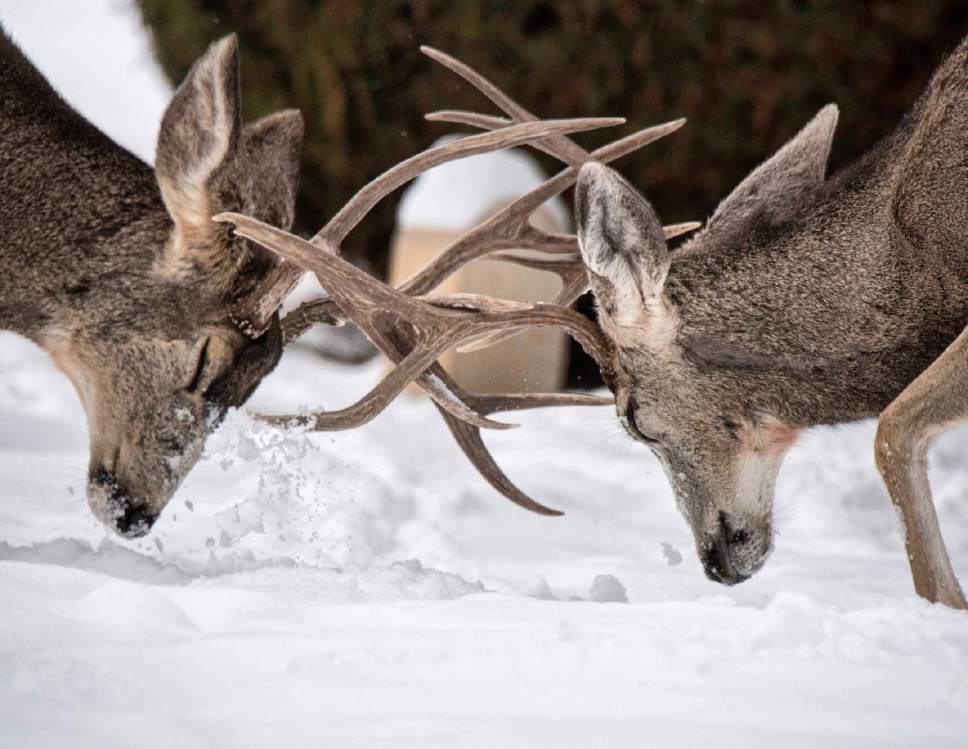This is an archived article that was published on sltrib.com in 2017, and information in the article may be outdated. It is provided only for personal research purposes and may not be reprinted.
The main cause of mule deer mortality in Utah is not hunters, predators or even motor vehicles. It's winter and this January is taking a serious toll, prompting officials to begin emergency feeding operations in four northern Utah counties.
The state effort is likely to expand as snow continues to pile up in the Uinta, Wasatch and Bear River ranges, burying forage and pushing deer into the valleys in search of food.
Biologists with the Division of Wildlife Resources and volunteers began laying out pellets — specially formulated to meet deer's wintertime nutritional needs — near Bear Lake on Jan. 13, then this week in the Cache Valley and on private ranchlands near Kamas.
"Our preference is to rely on natural conditions; we do a lot of work to managed natural habitats, but a lot of them have been fragmented," said Phil Douglass, DWR's northern regional outreach manager. "Because of that disruption we have an emergency feeding policy."
DWR will put out pellets when three criteria are met: snow pack exceeds 20 inches in depth; temperatures remain below long-term averages; normal food sources remains unavailable because of snow cover.
This winter's relentless snowfall is a boon to Utah's drought-starved reservoirs, but it has accentuated the struggle for survival deer, especially fawns, face this time of year.
Roads crossing migration routes, urban sprawl, foothill residential development have displaced deer from their natural winter haunts. These alternations to the landscape now mean feeding is necessary to prevent big die-offs during harsh winters, according to Kirk Robinson of the Western Wildlife Conservancy.
"Habitat and climate are what drive deer population," Robinson said. "If deer had more winter range, we wouldn't be doing this."
DWR officials conceded habitat is a big challenge to deer survival, especially where highways cross migration routes and subdivisions eliminate winter range, but allowing deer to congregate on private land at the expense of farmers or to die in droves is not acceptable to the public.
With help from members of the Mule Deer Foundation, Sportsmen for Fish and Wildlife and Rocky Mountain Elk Foundation, DWR is dumping pellets this week at various sites chosen to keep deer away from residences, pets and roads.
The pellets are designed to mimic the brushy, woody forage they normally eat in winter.
The sight of starving deer in nearby yards and fields often prompts residents to put hay out for them. But the public is strongly encouraged against such acts of empathy, which could put these stressed animals in even greater peril, according to Randy Wood, DWR's regional wildlife manager
"Deer have complex and delicate digestive systems. If you feed the wrong food to a deer, the animal can actually starve to death, even though its stomach is full of food," Wood said.
DWR used to put the feed in troughs, Douglass said. "But there was competition for the food and we see losses among younger and less aggressive deer."
Now biologists spread out the food, laying it directly on the snow in long piles, in an effort to reduce that competition.
Brian Maffly covers public lands for The Salt Lake Tribune. Maffly can be reached at bmaffly@sltrib.com or 801-257-8713.
Twitter: @brianmaffly





